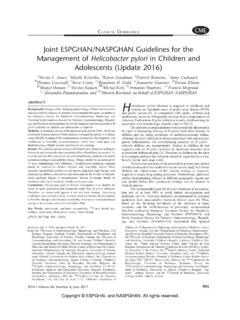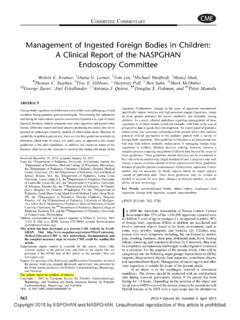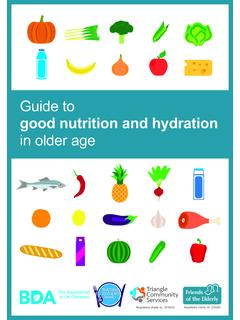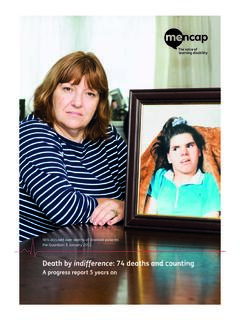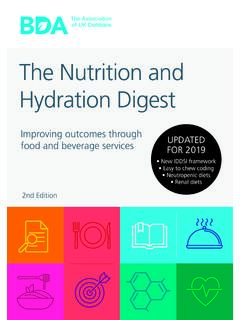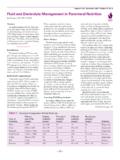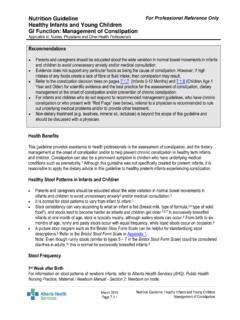Transcription of North American Society for Pediatric Gastroenterology ...
1 Copyright 2008 by Lippincott Williams & reproduction of this article is ReportNorth American Society for Pediatric Gastroenterology ,Hepatology, and Nutrition Consensus Statement on the Diagnosisand Management of Cyclic Vomiting Syndrome B Li,yFrank Lefevre,zGisela G. Chelimsky, Richard G. Boles,jjSusanne P. Nelson, Donald W. Lewis,#Steven L. Linder, Robert M. Issenman, and Colin D. Rudolph Medical College of Wisconsin, Milwaukee,{Northwestern University,{Case Western Reserve University, Cleveland, OH, Children s Hospital of Los Angeles, Los Angeles, CA,jjChildren s Gastroenterology Specialists, Glenview, IL, Children s Hospitalof the King s Daughters, Norfolk, VA,#Dallas Pediatric Neurology Associates, Dallas, TX, and McMaster University, Hamilton,ON, CanadaABSTRACTC yclic vomiting syndrome (CVS) is a disorder noted for itsunique intensity of vomiting, repeated emergency departmentvisits and hospitalizations, and reduced quality of life.}}
2 It is oftenmisdiagnosed due to the unappreciated pattern of recurrenceand lack of confirmatory testing. Because no accepted approachto management has been established, the task force was chargedto develop a report on diagnosis and treatment of CVS basedupon a review of the medical literature and expert opinion. Thekey issues addressed were the diagnostic criteria, the appro-priate evaluation, the prophylactic therapy, and the therapy ofacute attacks. The recommended diagnostic approach is toavoid shotgun testing and instead to use a strategy of targetedtesting that varies with the presence of 4 red flags: abdominalsigns (eg, bilious vomiting, tenderness), triggering events (eg,fasting, high protein meal), abnormal neurological examination(eg, altered mental status, papilledema), and progressiveworsening or a changing pattern of vomiting episodes. Thera-peutic recommendations include lifestyle changes, prophylactictherapy (eg, cyproheptadine in children 5 years or younger andamitriptyline for those older than 5), and acute therapy (eg, 5-hydroxytryptamine receptor agonists, termed triptans herein, asabortive therapy, and 10% dextrose and ondansetron for thoserequiring intravenous hydration ).
3 This document represents theofficial recommendations of the North American Society forPediatric Gastroenterology , Hepatology and Nutrition for thediagnosis and treatment of CVS in children and :379 393, Words:CVS Cyclic vomitingsyndrome Diagnosis Treatment.#2008 by EuropeanSociety for Pediatric Gastroenterology , Hepatology, andNutritionandNorthAmericanSocietyforPe diatricGastroenterology, Hepatology, and NutritionCyclic vomiting syndrome (CVS) is a disorder charac-terized by recurrent, discrete, self-limited episodes ofvomiting and is defined by symptom-based criteria andthe absence of positive laboratory, radiographic, andendoscopic testing (1 3). Affected children are moreoften girls than boys (60:40), of elementary school age(ranging from infants to young adults), and more oftenwhite. Despite this being an episodic disorder, a largecase series found that although it affects only 5% to 15%of a child s lifetime, it results in 24 days of missed schooland an annualized cost of care of $17,035 (4).
4 Affectedchildren usually experience a stereotypical pattern ofvomiting typified by a consistent time of onset, duration,and symptoms. The vomiting is intense (median 6 times/hour at peak), often bilious (83% in some series), andaccompanied by disabling nausea (4). The resultingdehydration necessitates a high rate of intravenousreplenishment. The accompanying symptoms includingpallor, listlessness, anorexia, nausea, retching, abdominalpain, headache, and photophobia may make it difficult todistinguish episodes of CVS from other causes of acuteabdomen and altered consciousness. Episodes often com-mence in the early morning (eg, 3 4 AM or upon awa-kening) and are frequently triggered by psychological(eg, birthdays, holidays, school-related) and physicalstress (eg, infections, lack of sleep, menstrual periods).CVS starts commonly in early childhood, and the vomit-ing symptoms may abate with the onset of classicalmigraine headaches during adolescence.
5 Less commonlyReceived February 21, 2008; accepted February 21, disclosures appear at the end of the of Pediatric Gastroenterology and Nutrition47:379 393#2008 by European Society for Pediatric Gastroenterology , Hepatology, and Nutrition andNorth American Society for Pediatric Gastroenterology , Hepatology, and Nutrition379 Copyright 2008 by Lippincott Williams & reproduction of this article is condition persists into adulthood or starts in adult-hood (5 7).The etiology and pathogenesis remain unknown butthere appears to be a strong link between CVS andmigraine, based upon similarities in symptoms, commoncoexistence of both conditions in the same individual, ahigh family prevalence of migraine in patients with CVS,and the effectiveness of antimigraine therapy (8 11).Postulated mechanisms include episodic dysautonomia,mitochondrial DNA mutations that cause deficits incellular energy production and/or heightened hypothala-mic stress response that activates the emetic response(12 14).
6 CVS presents with vomiting and a variety ofassociated symptoms that could represent either differinglevels of severity or even distinct pathophysiologicalmechanisms. These presentations include subgroups suchas migraine-associated, menses-associated, and Sato sub-type (15,16) with episode-associated hypertension andelevated adrenocorticotropin North American Society for Pediatric Gastroen-terology, Hepatology and Nutrition (NASPGHAN)appointed a task force to develop a consensus reportfor CVS to improve the recognition and treatment of adisorder that lacks standard medical approaches. Anabsence of controlled trials and high-quality scientificevidence in this disorder necessitated that these recom-mendations be based primarily upon small clinical trialsand expert opinion. Despite these limitations, the com-mittee used a rigorous review process, akin to that usedfor development of clinical practice guidelines, to pro-vide useful recommendations for patient managementbased upon the available literature and clinical experi-ence.
7 These recommendations are intended for use bypediatricians, family physicians, Pediatric gastroenterol-ogists, Pediatric neurologists, and emergency departmentphysicians. Although there appear to be an increasingnumber of adults diagnosed with this disorder, it wasbeyond the purview of this task force to develop manage-ment principles for adult expert task force reviewed the evidence andproposed recommendations for the evaluation and treat-ment of CVS. The task force consisted of 9 experts drawnfrom the fields of Pediatric Gastroenterology , pediatricneurology, Pediatric genetics, and epidemiology. Thisreport was developed by consensus of the CVS taskforce, using a modified Delphi technique for systematic review of the literature was performed toidentify all of the published articles through 2007 thatcontained primary data on the epidemiology, clinicalfeatures, natural history, and/or treatment of attention was directed toward articlesthat addressed the efficacy of treatment modalities forCVS.
8 The task force addressed four primary questions: How is CVS defined?The task force considered themost appropriate clinical and laboratory data to beused in diagnosing CVS. Recognizing the lack ofdefinitive laboratory markers, the heterogeneousnature of the disorder, and the variability ofdiagnostic criteria in the literature, the task forcedeveloped an operational definition of CVS bynominal group technique. What is the appropriate laboratory, radiographic,and endoscopic evaluation in children with apattern of cyclic vomiting?After discussion thataddressed the known differences among inter-national Pediatric gastroenterologists as to theextent of laboratory evaluation that is performed inpatients with suspected CVS, the task force focusedon the following: the initial screening evaluation inan undifferentiated patient with episodic pattern ofvomiting meeting the cyclic vomiting criteria; thesensitivity of the various tests for serious surgicaland metabolic disorders; and alarm symptoms thatshould instigate a more thorough laboratoryevaluation.
9 The task force considered but did notfocus on the issues of subdividing patients byage, sex, race, ethnicity and clinical subgroups(eg, neurologically impaired). In patients with CVS, does prophylactic treatmentimprove long-term outcomes, as compared to notreatment or alternative treatment options?Thetask force evaluated the efficacy of prophylactictreatment including lifestyle changes such asavoidance of triggers, reassurance, education, andfamily support, and antimigraine and anticonvul-sant medications. The outcomes of prophylactictreatment included frequency of subsequent epi-sodes, duration and severity of episodes includingnumber of emeses, nausea, and other constitutionalsymptoms. The task force did divide treatmentgroups by age above and below 5 years, but did notfocus on other subgroups. During an acute attack of CVS, does treatmentimprove outcomes, as compared to no treatment oralternate treatment options?
10 The task forceevaluated the efficacy of abortive and supportivetreatment including intravenous fluid(s) containingdextrose, as well as medication including antie-metics, antimigraine triptans, sedatives, and non-steroidal anti-inflammatory drugs. The outcomesof the acute attack included length of episode,number of emeses, severity of nausea, and otherconstitutional symptoms. The task force didconsider but did not focus on issues of treatmentof various subgroups and criteria for ET Pediatr Gastroenterol Nutr, Vol. 47, No. 3, September 2008 Copyright 2008 by Lippincott Williams & reproduction of this article is Search StrategyMEDLINE was searched via PubMed using the fol-lowing terms: ( cyclic vomiting OR cyclic vomitingsyndrome OR cyclical vomiting OR CVS OR abdominal migraine OR periodic syndrome OR biliary attacks OR recurrent vomiting ) AND(pediatrics OR children OR infants) NOT Review [Pub-lication Type] during the years 1980 to the present.
